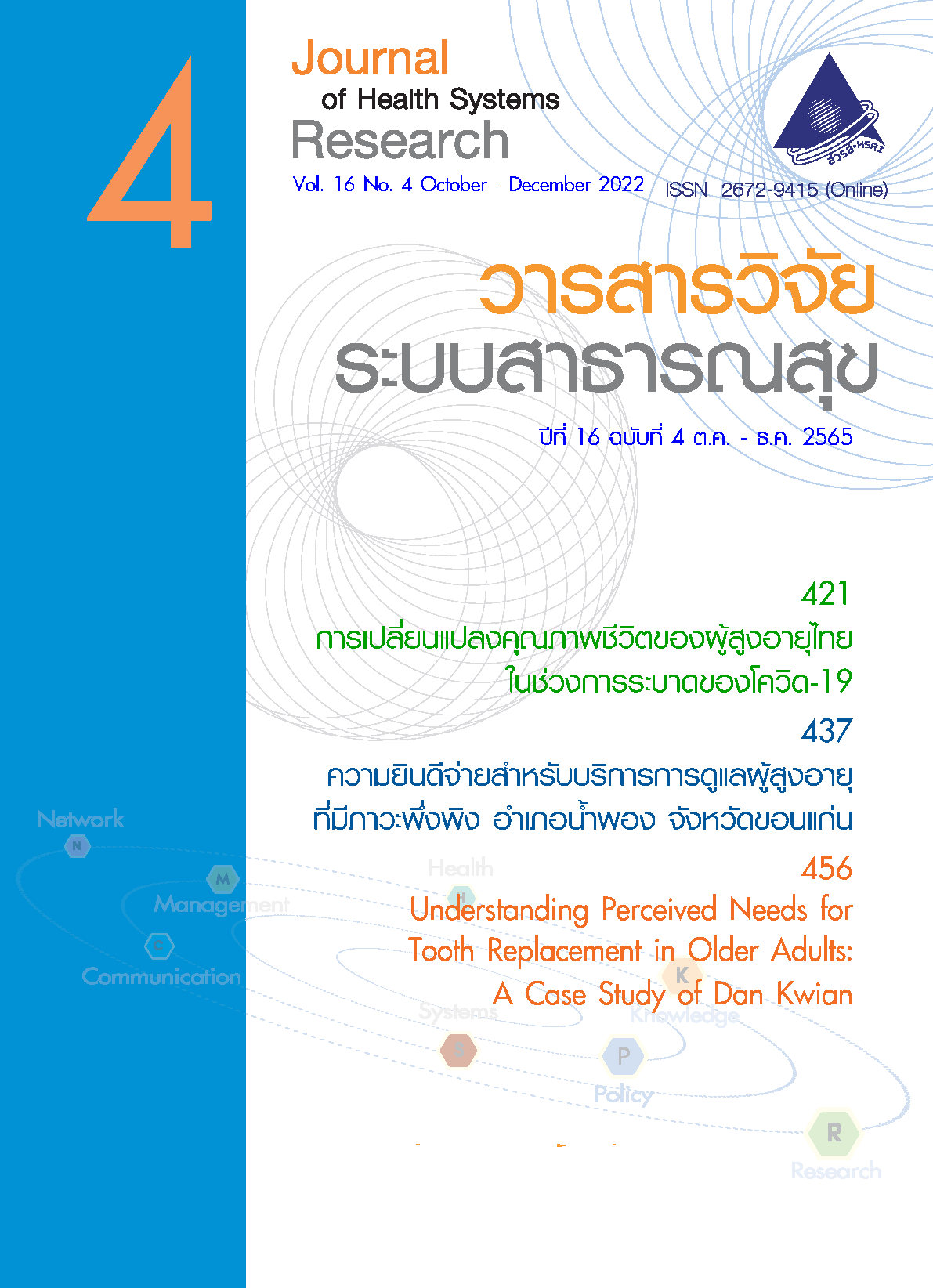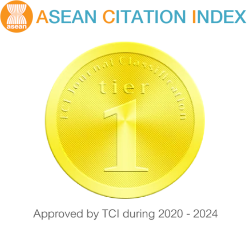ความรู้และความตระหนักเรื่องการใช้ยาปฏิชีวนะและเชื้อดื้อยาต้านจุลชีพของเจ้าหน้าที่ที่ปฏิบัติงานด้านสุขภาพและการจัดการการเพาะเลี้ยงสัตว์น้ำของประเทศไทย
คำสำคัญ:
การใช้ยาปฏิชีวนะ, เชื้อดื้อยาต้านจุลชีพ, ความรู้และความตระหนักเรื่องเชื้อดื้อยาต้านจุลชีพ, เจ้าหน้าที่เพาะเลี้ยงสัตว์น้ำ, ประเทศไทยบทคัดย่อ
การเพาะเลี้ยงสัตว์น้ำเป็นอุตสาหกรรมทางการเกษตรที่มีความสำคัญต่อความมั่นคงทางอาหาร และการพัฒนาเศรษฐกิจของประเทศ โดยเฉพาะในกลุ่มประเทศที่มีรายได้ต่ำและรายได้ปานกลาง อย่างไรก็ตาม ในกระบวนการผลิตสัตว์น้ำเกษตรกรอาจใช้ยาปฏิชีวนะอย่างไม่สมเหตุผลเพื่อป้องกันและรักษาโรคในสัตว์ที่เลี้ยง ซึ่งอาจทำให้เกิดปัญหาเชื้อดื้อยาต้านจุลชีพในมนุษย์และสิ่งแวดล้อม การศึกษาครั้งนี้มีวัตถุประสงค์เพื่อประเมินความรู้และความตระหนักเกี่ยวกับการใช้ยาปฏิชีวนะและการดื้อยาต้านจุลชีพของเจ้าหน้าที่ที่ปฏิบัติงานด้านสุขภาพและการจัดการการเพาะเลี้ยงสัตว์น้ำ และความรู้ของเจ้าหน้าที่เรื่องยาปฏิชีวนะและสารเคมีตามกฎหมายให้ใช้สำหรับสัตว์น้ำ โดยเก็บข้อมูลจากแบบสอบถามเรื่องความรู้และความตระหนักเรื่องการใช้ยาปฏิชีวนะและเชื้อดื้อยาต้านจุลชีพจากเจ้าหน้าที่ที่ปฏิบัติงานที่เกี่ยวข้องกับการเพาะเลี้ยงสัตว์น้ำ โดยทำการศึกษาในเดือนกุมภาพันธ์ พ.ศ. 2562 ข้อคำถามประกอบด้วย 4 หัวข้อ ได้แก่ 1) ความรู้เรื่องแผนยุทธศาสตร์การจัดการการดื้อยาต้านจุลชีพแห่งประเทศไทย พ.ศ. 2561-2564 2) ความรู้เรื่องยาปฏิชีวนะ 3) ความตระหนักต่อปัญหาเชื้อดื้อยาต้านจุลชีพ และ 4) กฎหมายที่เกี่ยวข้องกับการใช้ยาและสารเคมีในสัตว์น้ำ มีผู้ตอบแบบสอบถาม 92 คน ซึ่งเป็นเจ้าหน้าที่ที่ปฏิบัติงานด้านสุขภาพในการจัดการการเพาะเลี้ยงสัตว์น้ำจาก 61 จังหวัดของประเทศไทย ผู้ตอบแบบสอบถามมากกว่าครึ่งทราบว่าประเทศไทยมีแผนยุทธศาสตร์การจัดการการดื้อยาต้านจุลชีพประเทศไทย พ.ศ. 2560-2564 (ร้อยละ 57.6) แต่ส่วนใหญ่ของผู้ที่ทราบนั้น ไม่ทราบเนื้อหาสาระในแผนยุทธศาสตร์ฯ (ร้อยละ 62.3) ผู้ตอบแบบสอบถามมีความรู้ที่เกี่ยวข้องกับยาปฏิชีวนะผ่านการตอบคำถามทั้งหมด 6 ข้อ อยู่ในระดับสูง โดยร้อยละ 73.9 ตอบถูกมากกว่า 3 ข้อขึ้นไป โดยประเด็นที่มีความเข้าใจถูกต้องมากที่สุด ได้แก่ “ควรหยุดใช้เมื่อได้รับยาฆ่าเชื้อ/ยาปฏิชีวนะครบถ้วน (ตามที่แพทย์/บุคลากรทางการแพทย์แนะนำ)” และ “การใช้ยาฆ่าเชื้อ/ยาปฏิชีวนะโดยไม่จำเป็นทำให้การรักษาไม่ได้ผลหรือเชื้อดื้อยา” ร้อยละ 94.6 และ 90.2 ตามลำดับ ผู้ตอบแบบสอบถามมากกว่าร้อยละ 80.0 ตอบถูกเรื่องยาและสารเคมี ที่กรมประมงอนุญาตและไม่อนุญาตให้ใช้สำหรับสัตว์น้ำ อีกทั้งผู้ตอบแบบสอบถามทุกคนยอมรับว่าเชื้อดื้อยาต้านจุลชีพเป็นปัญหาที่ควรได้รับการพิจารณา การศึกษาครั้งนี้ เป็นการวัดระดับความรู้และความตระหนักเกี่ยวกับการใช้ยาปฏิชีวนะและเชื้อดื้อยาต้านจุลชีพในกลุ่มเจ้าหน้าที่ที่ปฏิบัติงานด้านสุขภาพและการจัดการการเพาะเลี้ยงสัตว์น้ำของประเทศไทยเป็นครั้งแรก โดยอ้างอิงข้อคำถามจากแบบการสำรวจอนามัยและสวัสดิการ พ.ศ. 2562 ผลการศึกษาแสดงให้เห็นว่าเจ้าหน้าที่มีความรู้และความตระหนักเรื่องการใช้ยาปฏิชีวนะและการดื้อยาต้านจุลชีพในระดับสูง แต่ควรมีการเผยแพร่นโยบายที่เกี่ยวข้องกับยาปฏิชีวนะ รวมถึงจัดอบรมให้ความรู้ที่ถูกต้องเกี่ยวกับยาปฏิชีวนะและเชื้อดื้อยาต้านจุลชีพให้แก่เจ้าหน้าที่ที่ปฏิบัติงานด้านสุขภาพและการจัดการการเพาะเลี้ยงสัตว์น้ำ เพื่อให้เจ้าหน้าที่สามารถนำความรู้ไปส่งเสริมการใช้ยาปฏิชีวนะอย่างสมเหตุผลในภาคการเพาะเลี้ยงสัตว์น้ำต่อไป
เอกสารอ้างอิง
World Health Organization. Global antimicrobial resistance surveillance system (GLASS) report: early implementation 2020. Geneva: World Health Organization; 2020.
O’Neill J. Review on antimicrobial resistance. Antimicrobial resistance: tackling a crisis for the health and wealth of nations [Internet]. London; 2014 [cited 2020 Mar 04]. Available from: https://amr-review.org/sites/default/files/AMR%20Review%20Paper%20-%20Tackling%20a%20crisis%20for%20the%20health%20and%20wealth%20of%20nations_1.pdf.
O’Neil J. Tackling drug-resistant infections globally: final report and recommendations. The review on antimicrobial resistance [Internet]. London; 2016 [cited 2020 Mar 04]. Available from: https://amr-review.org/sites/default/files/160518_Final%20paper_with%20cover.pdf.
Howell L. Global risks 2013. 8th ed. Geneva: World Economic Forum; 2013.
Huttner A, Harbarth S, Carlet J, Cosgrove S, Goossens H, Holmes A, et al. Antimicrobial resistance: a global view from the 2013 World Healthcare-Associated Infections Forum. Antimicrob Resist Infect Control. 2013;2(31):1-13.
Pokharel S, Raut S, Adhikari B. Tackling antimicrobial resistance in low-income and middle-income countries. BMJ Global Health. 2019;4:e002104.
Bakhit M, Del Mar C, Gibson E, Hoffmann T. Exploring patients’ understanding of antibiotic resistance and how this may influence attitudes towards antibiotic use for acute respiratory infections: a qualitative study in Australian general practice. BMJ Open. 2019;9:e026735.
Whittaker A, Lohm D, Lemoh C, Cheng AC, Davis M. Investigating understandings of antibiotics and antimicrobial resistance in diverse ethnic communities in Australia: findings from a qualitative study. Antibiotics (Basel). 2019;8:135-52.
Holmes A, Luke M, Arnfinn S, Martin S, Sadie R, Abhilasha K, et al. Understanding the mechanisms and drivers of antimicrobial resistance. Lancet. 2016;387(10014):176-87.
Centers for Disease Control and Prevention. Antibiotic resistance questions and answers [Internet]. 2020 [cited 2020 Mar 04]. Available from: https://www.cdc.gov/antibiotic-use/antibiotic-resistance.html#.
Mayor S. First WHO antimicrobial surveillance data reveal high levels of resistance globally. BMJ. 2018;360:k462.
European Centre for Disease Prevention and Control. An agency of the European Union. Factsheet for the general public-antimicrobial resistance. [cited 2020 Mar 04]. Available from: https://www.ecdc.europa.eu/en/antimicrobial-resis-tance/facts/factsheets/general-public.
World Health Organization. Global action plan on antimicrobial resistance [Internet]. 2016 [cited 2020 Mar 04]. Available from: https://www.who.int/publications/i/item/9789241509763.
ICF, EU Insights. Perceptions on the human health impact of antimicrobial resistance (AMR) and antibiotics use in animals across the EU. EFSA supporting publication [Internet]. 2017 [cited 2020 Mar 04]. Available from: https://efsa.onlinelibrary.wiley.com/doi/pdfdirect/10.2903/sp.efsa.2017.EN-1183.
Martino GD, Crovato S, Pinto A, Dorotea T, Mascarello G, Brunetta R, et al. Farmers’ attitudes towards antimicrobial use and awareness of antimicrobial resistance: a comparative study among turkey and rabbit farmers. Italian Journal of Animal Science. 2019;18:194-201.
Ministry of Public Health, Thailand. Thailand’s National Strategic Plan on Antimicrobial Resistance 2017–2021 [Internet]. 2017. [cited 2020 Mar 04]. Available from: https://rr-asia.woah.org/wp-content/uploads/2020/03/thailand_thai-lands-national-strategic-plan-on-amr-2017-2021.pdf.
Chanvatik S, Lekagul A, Vongmongkol V, Patcharanarumol W, Thunyahan A, Tangcharoensathien V. Situation on antimicrobial use and knowledge on antimicrobials: a national health and welfare survey in Thailand 2017. Journal of Health Systems Research. 2018;12(3):420-36. (in Thai)
Thai Working Group on Health Policy and Systems Research on Antimicrobial Resistance (HPSR-AMR). Consumption of antimicrobial agents in Thailand in 2017 [Internet]. [cited 2020 Mar 5]. Available from: https://cms.thaiamrwatch.net/uploads/2017_Consumption_of_antimicrobial_agents_in_Thailand_in_2017_version_2_Excluding_export_b8817cc5aa.pdf.
Chanvatik S, Donnua S, Lekagul A, Kaewkhankhaeng W, Vongmongkol V, Athipunyakom P, et al. Antibiotic use in mandarin production (Citrus reticulata Blanco) in major mandarin-producing areas in Thailand: a survey assessment. PLoS ONE. 2019;14(11):e0225172.
Boonyasiri A, Tangkoskul T, Seenama C, Saiyarin J, Tiengrim S, Thamlikitkul V, et al. Prevalence of antibiotic resistant bacteria in healthy adults, foods, food animals, and the environment in selected areas in Thailand. Pathogens and Global Health. 2014;108(5):235-45.
Cooperative Auditing Department. Economic situation of fishery cooperatives and trend direction in 2019 [Internet]. [cited 2020 Mar 5]. Available from: https://www.cad.go.th/ewt_news.php?nid=40060&filename=index. (in Thai)
Notification of the Ministry of Public Health (No. 299) B.E. 2549 (2006) Re: Standards for food contaminated with certain chemicals (No. 2) [Internet]. [cited 2021 Aug 4]. Available from: http://food.fda.moph.go.th/law/data/announ_moph/P299.pdf. (in Thai)
Notification of the Ministry of Agriculture and Cooperatives (Nov. 29, 2019) Re: Requirements for marine shrimp aquaculture operators which are controlled aquaculture businesses within the aquaculture area, section 77 of the Fisheries Royal Ordinance B.E. 2558 must be in practice 2019 [Internet]. The Royal Government Gazette Volume 136, Special Section 312 Ngor. (Dec 23, 2019) [cited 2021 Oct 2]. Available from: https://www4.fisheries.go.th/local/file_document/20200807102438_1_file.PDF. (In Thai)
Tangcharoensathien V, Chanvatik S, Kosiyaporn H, Kirivan S, Kaewkhankhaeng W, Thunyahan A, et al. Population knowledge and awareness of antibiotic use and antimicrobial resistance: results from national household survey 2019 and changes from 2017. BMC Public Health. 2021;21(2188):1-14.
European Commission. Special Eurobarometer 478: antimicrobial resistance report. 2018.
Yuto T, Ketsin T, Anantasan P, Siltrakool B, Kangwanrattanakul K, Phanudulkitt C. Consumers’ awareness, expectation, and behaviors related to antibiotic use of consumers in community pharmacies in Saensuk municipality, Chonburi province. The Public Health Journal of Burapha University. 2020;15(2):1-12.
Kamata K, Tokuda Y, Gu Y, Ohmagari N, Yanagihara K. Public knowledge and perception about antimicrobials and antimicrobial resistance in Japan: a national questionnaire survey in 2017. PLoS One. 2018;13(11):e0207017.
Kristina SA, Wati MR, Prasetyo SD, Fortwengel G. Public knowledge and awareness towards antibiotics use in Yogyakarta: a cross sectional survey. Pharm Sci Asia. 2020;47(2):173-80.
The Coordination and Integration Committee on Antimicrobial Resistance. Landscape of antimicrobial resistance situation and action in Thailand [Internet]. Bangkok: Aksorn Graphic Design; 2015 [cited 2021 Feb 4]. Available from: https://www.fda.moph.go.th/sites/drug/Shared%20Documents/AMR/06.pdf. (in Thai)
Department of Fisheries-Advise farmers to appropriate antibiotic use in aquaculture to reduce antimicrobial resistance and for the safety of consumers [Internet]. [cited 2021 Sep 30]. Available from: https://www4.fisheries.go.th/index.php/dof/news_local/1210/106464. (in Thai)
Adams A. Progress, challenges and opportunities in fish vaccine development. Fish Shellfish Immunol. 2019;90:210-14.
Ma J, Bruce TJ, Jones EM, Cain KD. A review of fish vaccine development strategies: conventional methods and modern biotechnological approaches. Microorganisms. 2019;7(11):569..
ดาวน์โหลด
เผยแพร่แล้ว
รูปแบบการอ้างอิง
ฉบับ
ประเภทบทความ
สัญญาอนุญาต
ลิขสิทธิ์ (c) 2025 วารสารวิจัยระบบสาธารณสุข

อนุญาตภายใต้เงื่อนไข Creative Commons Attribution-NonCommercial-NoDerivatives 4.0 International License.
วารสารวิจัยระบบสาธารณสุขอยู่ภายใต้การอนุญาต Creative Commons Attribution-NonCommercial-NoDerivatives 4.0 International (CC BY-NC-ND 4.0) เว้นแต่จะระบุไว้เป็นอย่างอื่น



